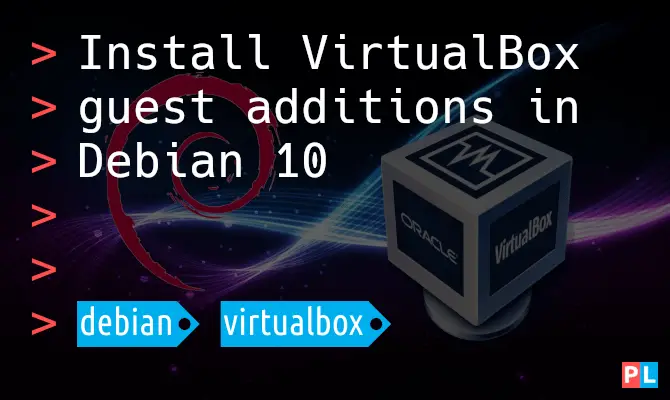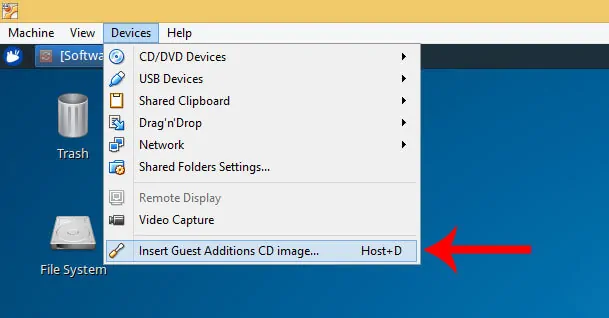

- #Virtualbox guest additions linux install
- #Virtualbox guest additions linux windows 10
- #Virtualbox guest additions linux iso
It is also recommended to install the virtualbox-guest-iso package on the host running VirtualBox. To use the USB ports of your host machine in your virtual machines, add users that will be authorized to use this feature to the vboxusers user group. Note: If the VirtualBox kernel modules were loaded in the kernel while you updated the modules, you need to reload them manually to use the new updated version. scripts/sign-file sha1 certs/signing_key.pem certs/signing_key.x509 $module done # for module in `ls /lib/modules/$(uname -r)/kernel/misc/` do. Navigate to your kernel tree folder and execute the following command: When using a custom kernel with CONFIG_MODULE_SIG_FORCE option enabled, you must sign your modules with a key generated during kernel compilation. When either VirtualBox or the kernel is updated, the kernel modules will be automatically recompiled thanks to the DKMS pacman hook. To compile the VirtualBox modules provided by virtualbox-host-dkms, it will also be necessary to install the appropriate headers package(s) for your installed kernel(s) (e.g. for any other kernel (including linux-lts), choose virtualbox-host-dkms.for the linux kernel, choose virtualbox-host-modules-arch.You will also need to choose a package to provide host modules:

In order to launch VirtualBox virtual machines on your Arch Linux box, follow these installation steps.
 5.26 Failed to save the settings when enabling Secure Boot. 5.25 Freeze during virtual machine startup with 11th generation Intel CPU.
5.26 Failed to save the settings when enabling Secure Boot. 5.25 Freeze during virtual machine startup with 11th generation Intel CPU. #Virtualbox guest additions linux windows 10
5.24 Random crashes with Windows 10 guest OS with Intel Tiger Lake chipset.5.23 Unable to view desktop in fullscreen mode.5.22 Random freezing in guests with intel graphics.5.21 Cannot launch VirtualBox with Wayland: Segmentation fault.
 5.20 Windows: Screen flicker if 3D acceleration enabled. 5.19 WinXP: Bit-depth cannot be greater than 16. 5.18 Windows 8, 8.1 or 10 fails to install, boot or has error "ERR_DISK_FULL". 5.16 Windows: "The specified path does not exist. 5.15 OpenBSD unusable when virtualisation instructions unavailable. 5.14 NS_ERROR_FAILURE and missing menu items. 5.11 Failed to create the host-only network interface.
5.20 Windows: Screen flicker if 3D acceleration enabled. 5.19 WinXP: Bit-depth cannot be greater than 16. 5.18 Windows 8, 8.1 or 10 fails to install, boot or has error "ERR_DISK_FULL". 5.16 Windows: "The specified path does not exist. 5.15 OpenBSD unusable when virtualisation instructions unavailable. 5.14 NS_ERROR_FAILURE and missing menu items. 5.11 Failed to create the host-only network interface. #Virtualbox guest additions linux iso
5.10 Problems with images converted to ISO. 5.8 Host freezes on virtual machine start. 5.3 VirtualBox GUI does not match host GTK theme. 5.1 Keyboard and mouse are locked into virtual machine. 4.14.1 SSHFS as alternative to the shared folder. 4.12 Run an entire physical disk in Virtualbox. 4.11.6 Configuring the virtual UEFI firmware and creating Windows boot files. 4.11.5 Adding virtual disks to the virtual machine. 4.11.4 Setting up a separate ESP partition. 4.11.3.2 Lower security option: using 'disk' group. 4.11.3.1 Higher security option: using a dedicated group for the Windows partitions. 4.11.3 Allowing VirtualBox to read physical partitions. 4.11 Run a native Windows installation inside VirtualBox. 4.10.4 Fix MBR and Microsoft bootloader. 4.10.2 Using Disk2vhd to clone Windows partition. 4.10 Move a native Windows installation to a virtual machine. 4.9.2 UEFI interactive shell after restart. 4.9.1 No keyboard/mouse input when attempting to install Mojave. 4.8 Install a native Arch Linux system from VirtualBox. 4.7.3.2 Create the VM configuration file. 4.7.3 Create a VM configuration to boot from the physical drive. 4.7.2 Make sure your mkinitcpio image is correct. 4.7.1 Make sure you have a persistent naming scheme. 4.7 Run a native Arch Linux installation inside VirtualBox. 4.3.2 Detecting web-cams and other USB devices. 4.3 Use specific device in the virtual machine. 4.2.2 Starting virtual machines with a keyboard shortcut. 4.2.1 Starting virtual machines with a service (autostart). 4.1.3 Create the VM configuration for your hypervisor. 4.1.2 Use the right virtual disk format. 4.1 Import/export VirtualBox virtual machines from/to other hypervisors. 3.7 Clone a virtual disk and assigning a new UUID to it. 3.6.1 Transfer between Linux host and other OS. 3.6 Replace a virtual disk manually from the. 2 Installation steps for Arch Linux guests. 1.4 Accessing host USB devices in guest. 1 Installation steps for Arch Linux hosts.








 0 kommentar(er)
0 kommentar(er)
